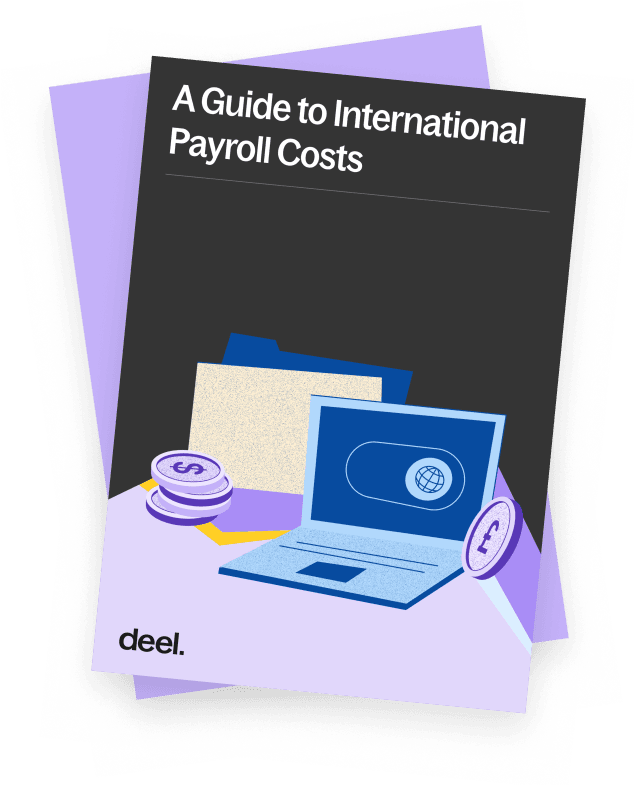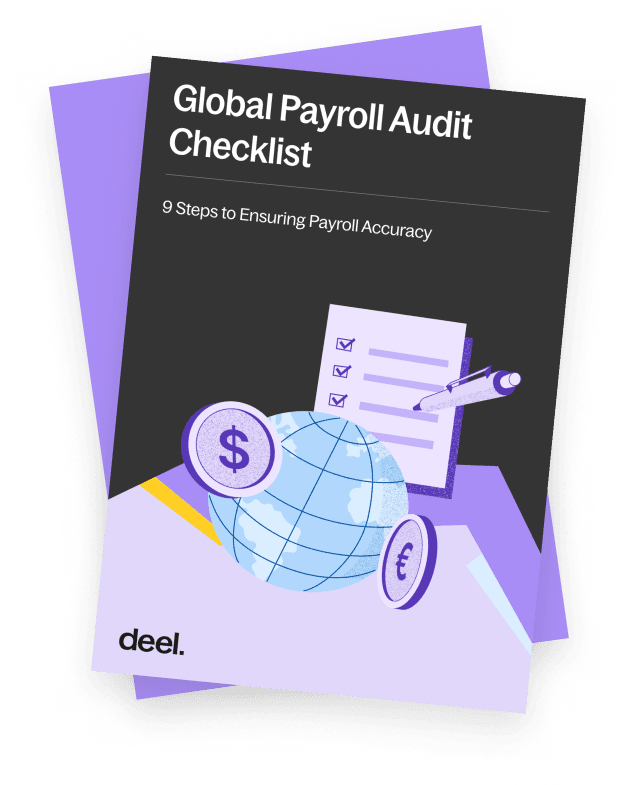Remote Work Glossary
- Results for "undefined"
Table of Contents
How does on-demand pay work?
How does on-demand pay work for global and remote teams?
Benefits of on-demand pay for employers
Benefits of on-demand pay for employees
What are the possible downsides of on-demand pay?
FAQs about on-demand pay
Streamline your on-demand pay policies with Deel
What is on-demand pay
On-demand pay is a flexible payment arrangement that allows employees to access a portion of their earned wages before the scheduled payday.
Also known as instant pay, on-demand pay enables employees to receive their earnings within a few hours (or days) of completing their work rather than waiting until the end of their scheduled pay period. This could mean accessing a day’s wages or part of their salary before the usual payday.
In most instances, there is a maximum limit on the amount that workers can access before their pay date. The remaining wages are usually paid on the standard payday.
How does on-demand pay work?
Integrating with payroll systems is the first step in implementing a successful on-demand pay program. To ensure the employee’s final paycheck reconciles correctly, on-demand pay solutions must align with payroll systems on details like employee classification and payment processing.
When these processes are aligned correctly, it allows employees to access a portion of their wages before the scheduled payday without disrupting the normal payroll processes.
Employee eligibility
Before implementing an on-demand pay system, you must determine which employees are able to use the service. Establishing employee eligibility ensures the process is fair and minimizes the risk of managers and workers misusing the service.
Eligibility criteria may include:
- The length of time an employee has worked for the company,
- Their job position
- Their employment status (full-time or part-time)
Additionally, consider state and local laws, as well as industry-specific regulations that may apply to ensure compliance.
Continuous Compliance™
Payment processing and timing
When an eligible employee requests early pay, the on-demand pay software processes the payment and transfers the funds to the employee’s bank account or prepaid card. The timing of these payments varies depending on your policies and the payment method used.
For example, some on-demand pay services offer instant pay, while others take several hours or days to process and execute the payment request.
For the smoothest on-demand pay experience, share your company's on-demand pay policies and timelines with your workers.
How does on-demand pay work for global and remote teams?
For teams processing payroll internationally, on-demand pay takes on more layers of complexity due to different labor laws and financial systems at play. To set up on-demand pay for your remote or international workers, consider the following factors:
- The labor, payroll, and tax laws in each country
- The financial institutions available in each country and the payment methods they support
- Cultural perspectives about pay
With over 2,000 in-house experts in payroll, HR, and legal, Deel can help you navigate the intricacies of global payroll. We’ll automate your payroll tasks so that you get more time back and less headaches from tracking international payroll compliance.

Benefits of on-demand pay for employers
On-demand pay benefits employers by increasing employee retention, contributing to positive company culture, and providing a competitive edge in recruiting top talent.
Increased employee retention
On-demand pay is a powerful tool for increasing employee retention. By giving employees more control over their wages, you create a positive and supportive work environment that offers better financial stability.
Employees who feel valued and supported are more likely to stay with you long-term. According to research by Gallup, pay and benefits are the most common reasons employees left their job in 2024. Offering on-demand pay is a powerful way to align your people strategy with employee needs and boost retention.
Positive company culture
Offering on-demand pay establishes a culture of trust and respect with your employees. Supporting your workers’ financial needs demonstrates your commitment to their overall wellbeing.
It encourages them to be transparent and open with you, which creates a positive and supportive work environment that boosts productivity and job satisfaction. Employees who feel personally and financially supported at work are better positioned to perform at their best.
Competitive edge in recruiting
On-demand pay sets you apart as a desirable employer, helping you attract and retain the best talent. In fact, 59% of US employees identified greater work-life balance and wellbeing as the most important factor when considering a new job.
Offering on-demand wages gives you a competitive edge in the job market by demonstrating your flexibility with pay and concern for your workers’ financial wellbeing.
See also: Employer’s Guide to On-demand Pay: Definition, Uses, and Benefits
Benefits of on-demand pay for employees
The benefits of on-demand pay for employees includes financial wellness, employer support, and access to emergency funds.
Financial wellness
On-demand pay gives employees greater control over their cash flow. Early access to a portion of their salary means they don’t have to rely on expensive payday loans and credit cards for survival. This reduces financial stress, improving job satisfaction and productivity as a result.
Employer support
Many employers provide on-demand pay alongside other financial support programs designed to make employees’ personal lives as easy as possible. Additional programs may include financial literacy training, financial wellness programs, employer-backed loans, and more for holistic support.
Access to emergency funds
When unexpected things happen, such as major home or auto repairs, on-demand pay is the fastest way to access emergency funds. Because this money is earned, it's not a loan, so employees don't have to worry about high interest rates or long applications.
What are the possible downsides of on-demand pay?
Some errors may occur with on-demand pay if you fail to administer and integrate it well with the rest of your payroll. These include:
Transaction fees
Some providers charge a transaction fee every time you process an on-demand pay request. Administering on-demand pay also requires extra administrative and HR hours, depending on the level of support your payroll provider offers.
If you do not regulate how often employees can request early wages, these costs could quickly run up your overhead costs and disrupt your budget.
However, Deel Anytime Pay is completely free for both employers and employees, providing a truly global on-demand pay solution that works across currencies, countries, and compliance frameworks without adding administrative burden.
Risk of misuse
On-demand pay also carries the risk of employee misuse. Some employees may request funds often simply because they can and not for any legitimate use or emergency. The best way to minimize the risk of misuse is to:
- Establish clear on-demand pay policies and procedures
- Set amount limits for early payouts
- Perform regular reviews to monitor how often each employee uses the service
Cash flow challenges
Paying employees outside traditional pay dates can disrupt your cash flow and liquidity because it can be challenging to budget or prepare for on-demand pay requests.
If your cash flow dries out unexpectedly, you may have trouble fulfilling client orders, paying vendors, updating licenses, and more.
To address this risk:
- Include on-demand pay requests in your budget
- Balance your need to support employees with the need to maintain liquidity. This means limiting the number of requests per period an employee can make

Payroll disruption
Implementing on-demand pay requires changes to your existing payroll system and processes, which can be time-consuming when done manually. It can make end-of-month payments more difficult to trace because some employees are due for full pay while others are not.
The additional administrative tasks of managing early payouts and resolving technical issues may also impact your HR’s compensation packages. Streamlining the on-demand pay request process is the best way to protect your primary payroll system.
Payroll errors
If there is an error in your on-demand pay system, you may miscalculate an employee's wages and make a payroll error. These errors are difficult to fix on time because most workers use their salaries immediately after receiving them, giving you a tight window to catch and correct your error.
Availing portions of an employee's salary before their pay date also makes it more challenging to track variable forms of compensation, such as:
- Overtime
- Deductions
- Bonuses
- Commissions
To avoid pay errors, use a comprehensive solution like Deel Payroll that calculates, logs, and monitors employee wages in real time.
Deel Payroll
FAQs about on-demand pay
How does on-demand pay impact tax and payroll compliance?
When an employee receives an early payout, the payment is considered taxable income and must be reported on their annual tax return. This means you must withhold the appropriate amount of taxes from the employee’s regular paycheck and any on-demand pay payments.
You must also consider the impact of early pay on employee benefits packages like healthcare and retirement plans. Deel's payroll platform features an integrated compliance hub to help you adjust employee payments in line with local and regional law and your company's pay policy.
How can I implement an on-demand pay policy?
Implementing an on-demand pay policy requires careful planning and consideration of the potential pros and cons. Consider the following helpful tips for implementation:
- Establish your employees’ need for early pay: Conduct reviews and surveys to understand if and how much your workers need in early wages
- Pick a reputable provider like Deel Payroll to integrate the on-demand pay feature into your payroll without disrupting your traditional pay policies
- Integrate on-demand pay into your payroll system compliantly, taking into account local and regional labor laws regarding pay, taxes, and employee benefits
- Create and educate your team about your on-demand pay policy so they know when and how to use it. This should prevent misuse
- Evaluate the policy’s impact on your budget and cash flow a few months into the integration and adjust your on-demand pay policy accordingly

Checklist
Global Payroll Audit Checklist
Is on-demand pay a compliance issue?
Yes. Like other forms of payroll, on-demand pay is subject to local and federal payroll and tax regulations, with laws changing every day.
There is currently no federal law specifically targeting on-demand pay in the US. However, in 2024, congress introduced the Earned Wage Access Consumer Protection Act to the House, which is a first step toward regulating on-demand pay and earned wage access programs in the country.
State-wise, Missouri, Nevada, and Wisconsin have legal frameworks dictating the administration of on-demand pay, with four other states in the process of formulating their own. The policies protect workers from credit inquiries and hidden fees related to on-demand pay.
As an employer, you must provide on-demand pay to employees in line with the local, regional, or federal policies that apply to payroll in your area.
Streamline your on-demand pay policies with Deel
Deel is a people-first platform that not only processes payroll more efficiently, but also supports employees with greater financial flexibility and security.
Anytime Pay is our on-demand pay solution, built directly into Deel’s EOR infrastructure. Unlike other solutions, it works seamlessly across countries and compliance frameworks without disrupting payroll or adding administrative work.
Plus, Anytime Pay is free for both employers and employees, so you won’t have to worry about any unnecessary fees.
Request a demo to learn more and speak with our expert team.


